-

人教版新目标初中英语八年级下册What were you doing when the UFO arrived教案2篇
(一).知识方面: 1.培养学生能运用过去进行时来描述、谈论过去某个时间正在发生的事情或动作的意识和能力,能就过去某个时间正在发生的动作做出正确的描述。 2.培养学生的想象力和角色扮演的合作能力。 3.培养学生讲述过去发生的事情经过的能力。能正确运用一般过去时来讲述故事。 (二).技能方面: 1.本单元的语言目标是Talk about past events and tell a story(谈论过去的时间和讲述一个故事),围绕这一目标,要涉及句型: What were you doing when the UFO arrived? ----I was sitting in the barber’s chair. The barber was cutting my hair. 因此必须学习standing、studying、cleaning、sleeping、cooking、making、eating、cutting、等表示地点的词,以便为上述句型提供语言材料。2.学习过去进行时的有关知识。Was/were+现在分词,是该时态的表达式。 3.在学习过程中,要区分The boy was walking down the street when the UFO landed.和While the boy was walking down the street, the UFO landed.这两种由when和while引导的状语从句的句型结构。注意它们的不同。

人教版新目标初中英语八年级下册Why don’t you get her a scarf教案
教师带领学生复习有关描述宠物的词汇,采用教师提问学生回答的方进行。如:T:What animals do you think would be good pets?What animals do you think would be bad pets?What do you think are good animals for a six-year-old child?然后学生进行 pairwork 练习。Task two: 师生互动,学习探究 1、播放3a部分的录音,引导学生一边听录音,一边跟读。2、通过听录音学生回答以下问题:Why do you think pot-bellied pigs are popular?What are the advantages and disadvantages of keeping such a pet?教师对学生的回答进行及时点评。3.学习范文,学习重点短语,为下步的模仿写作提供语言素材。T :1. )Have you ever kept a pig as a pet?Do you like pigs? St.:No.…Why don’t you like to keep a pig? St: No.They’re too dirty and lazy(Do you know in some foreign countries like Hollyland, Australia,pigs are the most popular pet.there’s a kind of pig.(图)it has an interesting name? it ‘s called a pot-bellied pig.) Now,let’s learn an article about this kind of interesting pet.2.)play the tapeSt.:Listen and repeat3.)show some Qs on computer(本子St.: read silently,then answerthe Qs(本子)4.)Ask ss. Close book and retell this passage.(what is a pot-bellied pig? Is it a good or bad pet? ) St.: retell it to each other“A pot –bellied pig is a popular pet now…”5.read the article together.St.:.practice reading

人教版新目标初中英语八年级下册Would you mind turning down the music教案
Step 4. Group work (4)1. Ask a pair of students to read the dialogue. Say, This activity provides speaking, listening and writing practice using the target language.2. Ask students to complete the work in groups.3. Check the answers with the whole class. 4. Explain some of the language points. Step 5. Word review (Self check 1)1. Ask students to read the words and the phrases given. 2. Fill in the blanks with proper forms of these words to complete the sentences. 3. Check the answers with the whole class. Homework:Do activity 2 on page 57 after class. Period 6Teaching aims: 1. Teach vocabulary words and the useful expressions. 2. Enable the students to learn etiquette in different culture. 3. Help the students learn how to behave politely in public places and in daily life. Teaching procedures:Step 1. RevisionHelp students to review the function of making requests through a free talk. Then lead them to the topic of etiquette. Explain the meaning of etiquette. Or, ask students to look it up in the dictionary. Step 2. Pre-reading (Section 1)1. Ask students to read the picture and make a list with their partner about how many rules of etiquette can be seen being broken.

人教版新目标初中英语九年级下册By the time I got outside, the bus had already left教案
Ⅰ. Teaching Aims and Demands1. Knowledge Objects(1) Key Vocabularyoversleep(2) Target LanguageWhat happened?I overslept. And by the time I got up, my brother had already gotten in the shower.2. Ability Objects(1) Teach the students to use the new words.(2) Train the students to narrate past events with the Past Perfect Tense.(3) Train the students' listening and speaking skills with the target language.3. Moral ObjectIt’s a good habit to go to bed early in the evening and get up early in the morning. So you’ll never be in a hurry in the morning.Ⅱ. Teaching Key Points1. Key Vocabularyoversleep2. Target LanguageNarrate past events with the Past Perfect TenseⅢ. Teaching Difficult Points1. Train the students to narrate past events with the Past Perfect Tense.2. Train the students to understand the target language in spoken conversation.Ⅳ. Teaching Methods1. Thinking of examples from the students' real lives.2. Making sentences by looking at the pictures.Ⅴ. Teaching AidA tape recorderⅥ. Teaching ProceduresStep I Revision1. Revise the language points in Unit 8.Ask some questions like this: What volunteer work would you like to do?Help the students to answer, I’d like to…/I love to…/I hope to2. Practice the dialogue in Activity 3c on page 62 again. Get students to role play the similar dialogues with the following.

人教版新目标初中英语九年级下册Rainy days make me sad教案
1. 教材分析本单元以how do things affect you?为话题, 从颜色、天气、音乐、广告、产品等方面谈论了外界事物如何影响人的心情。要求学生掌握表达某物或某事给人带来的感觉、看法或影响等。共设计了四个部分的内容:Section A 该部分有4个模块:第一模块围绕Which restaurant would you like to go to?这一话题展开思维(1a)、听力(1b)、口语(1c)训练;第二模块围绕How does music affect you? 进行听力(2a-2b)、口语训练(2c);第三模块继续围绕how do colors in the restaurant affect you这一话题展开训练,训练形式为阅读和问题体验(3a)和小组活动(3b);第四模块仍就How do things affect you这一话题以调查的形式展开讨论。Section B该部分有4个模块:第一模块围绕产品广告对人们的影响这一话题以“配对”(1a)与“列举”(1b)两种形式展开训练;第二模块继续围绕How do things affect you? 进行听力(2a-2b)、口语对话训练(2c);第三模块围绕“Advertising”这一话题展开阅读(3a-3b)和写作(3c)训练;第四模块围绕How posters affect you这一话题以口语训练形式展开小组活动。

人教版新目标初中英语九年级下册Could you please tell me where the restrooms are教案
Step Ⅰ RevisionCheck homework. Ask a few students to read the article in 3a.Then ask a few students to read their guides.Step Ⅱ Part 1Look at the words in the box. Ask a student to read them. Make sure the students understand the meaning of the words. You are to fill in the blanks with the words. In some cases, students may need to use another form of the word, for example adjusting for tense or subject/ verb agreement.Ask students to fill in the blanks on their own.Check the answers. Step ⅢPart 2Go through the instructions with the class.Look at the example with the students.Ask students what the answer would be.Ask a student to read the question and answer it.Excuse me, could you tell me where the bank is, please?The bank is across the street from the shopping malt.Get students to complete the work in pairs.Check the answers. Ask a few students to read their questions.Step Ⅳ Just for Fun!Ask all the students to read the conversation. Ask: What is funny about this cartoon? Help students to explain. A Martian is a person from the planet Mars.There is no such thing as Martian food on Earth, and the clerk looks silly because he is trying to think of where there is a Martian restaurant.Invite some pairs of students to present this conversation to the rest of the class.Step Ⅴ Summary and HomeworkIn this class, we’ve done much writing practice using the key vocabulary words and the target language presented in this unit. After class, please finish the questions in 2 in your exercise books. Then finish the exercises on pages 47~48 of the workbook as well.The Seventh Period Ⅰ Teaching Aims and Demands1. Knowledge Objects(1) Key Vocabularyimage, adventure, jealousy, hero, crime, journey, brave, no longer, show interest in, take it easy, become interested in, plain looks(2)Text:Grown-ups like cartoons, too.2. Ability Objects(1) Fast-reading to get a general idea of the text.(2) Careful-reading to get the detailed information in the text.

人教版新目标初中英语九年级下册I’ll help clean up the city parks教案
Talk about offering help (P60)I’ll help clean up the city parks.A: I’d like to work ...B: You could help ...Talk about ways to tell people about the Clean-Up Day (P61)We need to ...We can’t ...I’ll ...Talk about the work the volunteers do (P62)These three students all volunteer their time to help other people.Somebody loves to ... / helps ... / plans to ... / wants to ...A: What do you like doing?B: I like ... A: What kind of volunteer work do you think I could do?B: You could ...1. 重点词汇advertisement, fix, repair, pleasure, blind, deaf, shut, carry, specially, fetch2. 认读词汇hunger, homeless, cheer, clean-up, sign, establish, major, commitment, elementary, veterinarian, coach, similar, call-in, strategy, disabled, organization, unable, support, appreciate, donation, part of speech, pronoun, adverb, preposition, conjunction, donate, Jimmy, Sally3. 词组clean up, cheer up, give out, put off, set up, think up, take after, fix up, give away, put up, hand out, work out, at once

人教版新目标初中英语九年级下册We’re trying to save the manatees教案2篇
本单元主要围绕着有关濒临灭绝的动物这一话题,学习了应该怎样保护我们的环境,以及就某一问题展开辩论。目标提示语言目标能够运用所学知识,就某一问题展开辩论。认知目标1、复习一些语法:现在进行时、一般现在时、用used to 表示一般过去时、现在完成时、一般过去时的被动语态。2、学会表达同意和不同意。3、学会以下基本句型:We’re trying to save the manatees.Manatees eat about 100 pounds of food a day.There used to be a lot of manatees.In 1972,it was discovered that they were endangered.Some of the swamps have become polluted.情感目标了解一些濒临灭绝的动物的生活习性和濒临灭绝的原因,教育学生应该如何保护环境。教学提示充分利用多媒体等教学设备,创设与本课话题相关的情境,如各种不同种类的动物、动物园以及有关环境的画画等等。围绕着本单元的教学目标,设计一些贴近学生实际的教学任务,如让学生谈论自己最喜欢的动物,如何拯救濒危动物,如何保护环境等等。让学生根据所学知识,就动物园是否对动物有利以及其他的话题进行辩论。

人教版新目标初中英语九年级下册You’re supposed to shake hands教案
教学目标:1. 掌握本单元一些重点词汇的写法和用法。2. 学会自如谈论餐桌礼仪。Step 1 RevisionAsk some students to retell the customs at the table in France in the passage in 3a.Step 2 Self checkPart 1. Fill in each bland with the correct word given. Students do the exercises by themselves at first. Then check the answers. Ask the students to comprehend the sentences and help them point out uses of some words, like “arrive (at / in) sw., spend time / money on sth , spend time / money (in) doing sth.”Part 2. Read about Fan Ling’s experience in a western restaurant. Understand the passage. Point out some key points in the passage.1. be / get used to doing sth. 习惯做某事2. begin with = start with 以….开头3. crowd v. 挤满,塞满 the crowd 人群 crowded adj. 拥挤的Then students discuss about how she would solve her problem. Ask some to share their stories with others.Part 3. Complete the crossword by looking at the sentences on the left. Then check the answers.
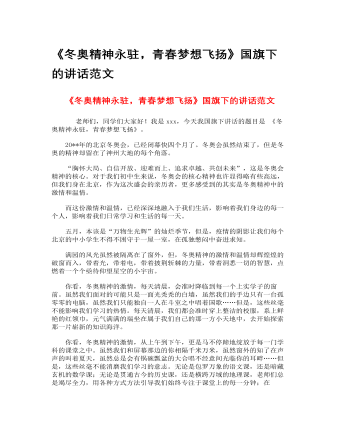
《冬奥精神永驻,青春梦想飞扬》国旗下的讲话范文
老师们,同学们大家好!我是xxx,今天我国旗下讲话的题目是 《冬奥精神永驻,青春梦想飞扬》。20**年的北京冬奥会,已经闭幕快四个月了。冬奥会虽然结束了,但是冬奥的精神却留在了神州大地的每个角落。“胸怀大局、自信开放、迎难而上、追求卓越、共创未来”,这是冬奥会精神的核心。对于我们初中生来说,冬奥会的核心精神也许显得略有些高远,但我们身在北京,作为这次盛会的亲历者,更多感受到的其实是冬奥精神中的激情和温情。而这份激情和温情,已经深深地融入于我们生活,影响着我们身边的每一个人,影响着我们日常学习和生活的每一天。
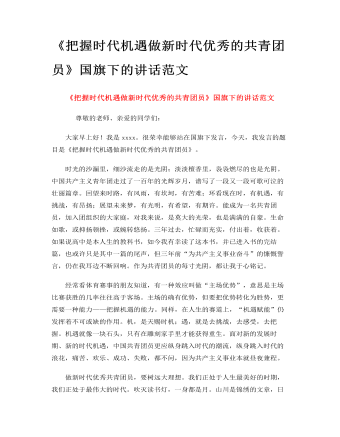
《把握时代机遇做新时代优秀的共青团员》国旗下的讲话范文
时光的沙漏里,细沙流走的是光阴;淡淡檀香里,袅袅燃尽的也是光阴。中国共产主义青年团走过了一百年的光辉岁月,谱写了一段又一段可歌可泣的壮丽篇章。回望来时路,有风雨,有坎坷,有苦难;环看现在时,有机遇,有挑战,有昂扬;展望未来梦,有光明,有希望,有期许。能成为一名共青团员,加入团组织的大家庭,对我来说,是莫大的光荣,也是满满的自豪。生命如歌,或抑扬顿挫,或婉转悠扬。三年过去,忙碌而充实,付出着,收获着。如果说高中是本人生的教科书,如今我有幸读了这本书,并已进入书的完结篇,也或许只是其中一篇的尾声,但三年前“为共产主义事业奋斗”的慷慨誓言,仍在我耳边不断回响。作为共青团员的每寸光阴,都让我于心铭记。
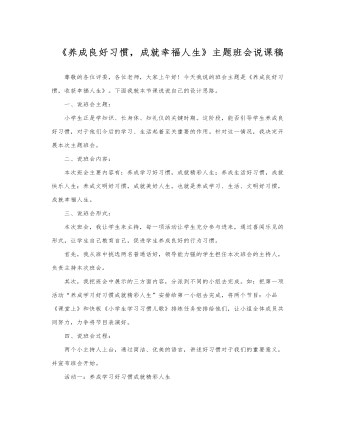
《养成良好习惯,成就幸福人生》说课稿
管得住自己,你是习惯的主人,管不住自己,你是习惯的奴隶。做主人,还是做奴隶全在于自己的选择。为了幸福,我们必须改掉身上的坏习惯。希望大家在好习惯的帮助下学有所成,寻找到自己的幸福。第二项:师生一起合唱《劳动最光荣》。教师结束语:在欢快的音乐中,我们的主题班会就要结束了。让我们把习惯的种子放在心里,让它在心中生根、发芽,收获一个美好的人生!五、说班会理念:养成教育要立足学生的生活实际,并服务于学生的生活。说得再多没用,重点是去行动,去做;只有实实在在的行动才能养成良好习惯。在本次班会中,我把课堂还给学生,让他们充分展示自我,充分发挥学生在课堂上的主体地位,调动学生的积极性,让学生全身心的投入到课堂中去,让学生即能得到思想的洗礼,又能得到能力的提高。以上是我对本节主题班会的设计的一些粗浅想法,不当之处还请各位评委、老师批评指正。
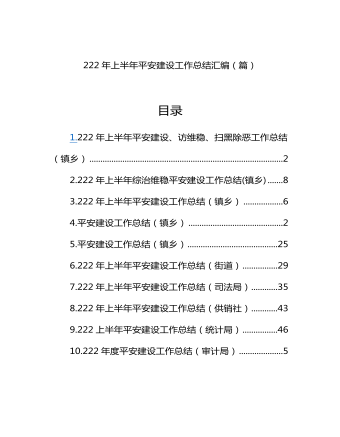
2023年上半年平安建设工作总结汇编10篇
一、综治(平安建设)情况一是强平台建设。222年上半年,xx镇按照上级规范建设标准要求,规范了综治中心平台,合理划分功能区,各项制度有序张贴上墙,配齐巡逻应急器,配齐配强综治中心工作力量。二是积极开展社会治安重点地区排查整治和“四创平安”等系列创建工作。每月坚持召开一次社会治安重点地区排查整治工作协调会议,研究部署重点地区排查整治工作。召开“安全感、满意度”双提升工作会议,开展进村入户宣传工作。积极开展“平安校园”“平安单位”“平安小区”“平安村”等系列平安创建活动,强组织领导,采取有力措施,主动适应人民群对平安的新需要,切实提升平安创建工作群知晓率和参与率,不断增强群安全感和满意度。三是“六项整治”专项整治活动。开展农村赌博专项整治活动,疫情期间全乡把所有麻将机封印,并对在巡逻期间发现的赌博人员进行处罚;整治封建迷,倡导移风易俗,打击不养不孝行为,措并举开展防范电网络诈骗PP下载安装和养老诈骗、防范养老领域非法集资整治等宣传活动,发放宣传品xxxx余份,PP下载安装完成xx%。常态开展扫黑除恶专项整治。召开摩托车交通违法集中专项整治工作会议,明确各单位职责,组织镇村干部签订驾乘摩托车安全承诺书,并要求各村在群中宣传签订承诺书。在集镇及学校开展摩托车交通违法集中整治宣传活动,现场接受咨询,发放“致摩托车驾驶人一封”xxxx余份,收到良好的宣传效果。
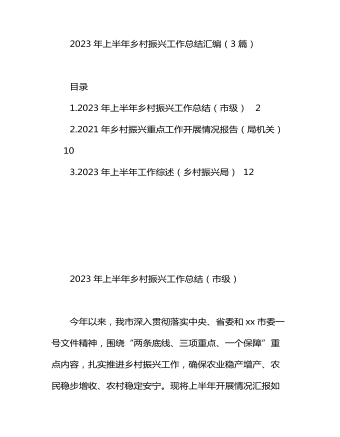
2023年上半年乡村振兴工作总结汇编(3篇)
今年上半年,全市农林牧渔业增加值xx.xx亿元,同比增长x.x%;规上企业农产品加工产值xx亿元,同比增长xx.x%;农村常住居民人均可支配收入xxxx元,同比增长x.x%,增速高于全国平均水平x.x个百分点。采取的主要措施有,(一)守住“两条底线”牢牢守住保障国家粮食安全的底线。一是稳定粮油生产和保障“菜篮子”稳产保供。抓好x.x万亩双季稻轮作项目建设,将粮食规划xx万亩生产面积及产量目标分解到各乡镇、各村,并纳入乡镇年终考核。制定xxxx年双季稻轮作项目实施方案和油菜轮作试点项目实施方案,推广优良品种,推广玉米大豆带状复合种植,多措并举扩面积、提产量。上半年稳定瓜果蔬菜播种面积xx万亩。积极推进xxxxx头种猪联合育种科研基地、xx农牧科技有限公司生猪养殖基地等养殖项目。二是严格落实耕地保护制度。坚决守住xx.xx万亩耕地红线和xx.xx万亩永久基本农田保护红线,防止耕地“非粮化”和撂荒。在xx镇等xx个乡镇创建xx个千亩以上双季稻生产示范片,同时创建x万亩双季稻高产示范片,调动农户积极性。xxxx年度高标准农田建设项目完成总工程量的xx%,xxxx年度高标准农田建设项目已完成两轮现场踏勘,正在进行初步设计。三是强化农业科技和物质装备支撑。深入实施水利补短板强功能三年行动(xxxx-xxxx年),已完成xxxx年度任务投资xxxx万元,目前xxxx年度任务已完成招投标,即将开工建设。选聘xx市级个人科技特派员xxx人,法人科技特派员团队x个,每个团队x人。开展线下科技培训服务活动x次,培训服务人数xxx余人次。
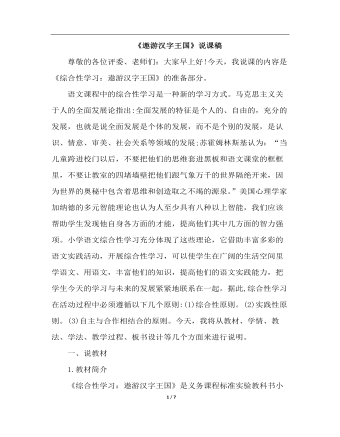
综合性学习:遨游汉字王国(说课稿)
一、说教材1.教材简介《综合性学习:遨游汉字王国》是义务课程标准实验教科书小学语文四年级上册第五组安排的一种学习形式。“遨游汉字王国”是由“汉字真有趣”和“我爱你,汉字”两个板块组成。“汉字真有趣”分别从字谜、有趣的谐音、汉字小笑话、汉字的起源等方面揭示了汉字的神奇性和趣味性。“我爱你,汉字”分别从汉字的演变、错别字的危害、汉字的书法艺术、汉字的魅力等方面,让学生了解中华汉字的灿烂文化。2.教学目标综合性学习是新课标对学生综合实践性学习活动重视的具体体现。它相对于学生来说是一种新的教学形式。通过本组的学习,学生可以了解到汉字历史的悠久,知道汉字记录并承载着中华的文明;同时还让学生清楚地看到汉字在今天同样具有强大的生命力,明白汉语如今在世界上影响的逐步扩大,从而激发学生学习汉字的兴趣和对祖国语言文字的热爱。根据本组教学的要求,结合实践活动的特点,联系学生的实际,我在摸索中制定了第一课时的教学目标:a、让学生感受汉字的音美、形美、意美。b、激发起学生探究汉字的欲望。c、让学生能根据兴趣爱好科学合理分组、分工,并能顺利开展活动。3.教学重点:让学生感受汉字的奇、趣、美,激发起学生的探知欲。
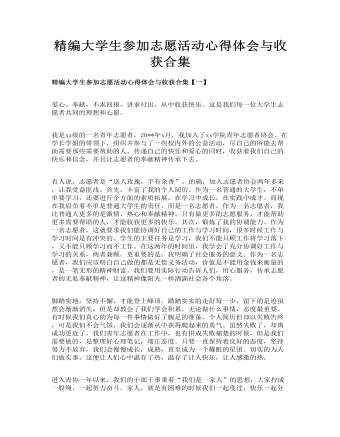
精编大学生参加志愿活动心得体会与收获合集
脚踏实地,坚持不懈,才能登上峰顶。踏踏实实的走好每一步,留下的足迹虽然会渐渐消失,但是却教会了我们学会积累。无论做什么事情,态度最重要。有时候我们真心的为每一件事情做好了腕足的准备,个人简历但却以失败告终,可是我们不会气馁,我们会逐渐从中获得爬起来的勇气。虽然失败了,却离成功更近了。我们青年志愿者在工作中,也有拼成失败痛楚的时候,但是我们需要做的,是整理好心理笔记,端正态度。只要一直保持着良好的态度,坚持努力不放弃,我们会慢慢成长,成熟,直至成为一个耀眼的星团。切实的为人们做实事,这便让人们心中温存了热,温存了让人快乐,让人感激的热。
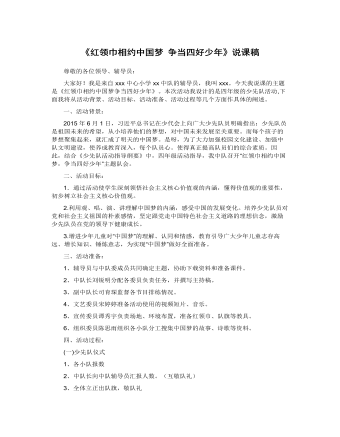
《红领巾相约中国梦 争当四好少年》说课稿
3、展梦想。第三小队通过演讲的形式,展示了自己的中国梦。队员分组通过朗诵诗歌、讲故事和演讲展示自己的中国梦,充分发表自己对社会主义核心价值观的理解,坚定争做四好少年的信心。〖设计意图:社会主义核心价值观比较抽象化,四年级的学生理解起来比较困难,让学生通过表演的形式,在某种程度上视觉感官接受要比抽象图更容易〗第三版块:深入研讨——领悟价值观看各小队表演之后,中队长启发队员们结合自身情况交流学习体会,讨论以下四个问题:(1)观看了视频和同学的表演后,你有什么感想?(2)如何学习树立自己的中国梦?(3)如何用实际行动践行社会主义核心价值观,实现自己的中国梦?让学生结合自身的特点,为自己设定合适的价值观。在此基础上让队员们齐声唱《红领巾心中飘》,道出自己心中的梦想。
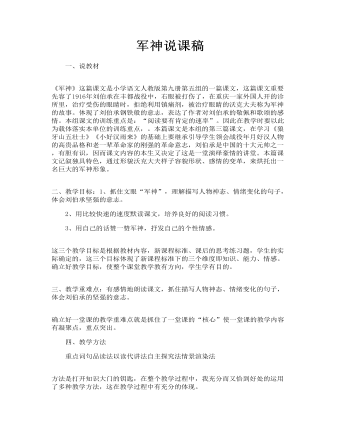
军神说课稿
二、教学目标:1、抓住文眼“军神”,理解描写人物神态、情绪变化的句子,体会刘伯承坚强的意志。 2、用比较快速的速度默读课文,培养良好的阅读习惯。 3、用自己的话赞一赞军神,抒发自己的个性情感。 这三个教学目标是根据教材内容,新课程标准、课后的思考练习题,学生的实际确定的,这三个目标体现了新课程标准下的三个维度即知识、能力、情感。确立好教学目标,使整个课堂教学教有方向,学生学有目的。 三、教学重难点:有感情地朗读课文,抓住描写人物神态、情绪变化的句子,体会刘伯承的坚强的意志。 确立好一堂课的教学重难点就是抓住了一堂课的“核心”使一堂课的教学内容有凝聚点,重点突出。 四、教学方法 重点词句品读法以读代讲法自主探究法情景渲染法 方法是打开知识大门的钥匙,在整个教学过程中,我充分而又恰到好处的运用了多种教学方法,这在教学过程中有充分的体现。

幼儿园小班科学说课稿 手机
“幼儿关注和发现生活中的科技成果。”这个目标属于科学领域的范畴。《纲要》中提出:从生活或媒体中幼儿熟悉的科技成果入手,引导幼儿感受科学技术对生活的影响,培养他们对科学的兴趣和对科学家的崇敬。这里提到了几个关键词:生活、熟悉,可见我们选择的科技成果的内容应该是从孩子的生活出发,为幼儿所熟悉的。 根据这个指导思想,我选择了“手机”,因为现在的家庭中至少有两部手机,有的甚至更多,孩子用手机打过电话、拍过照片、玩过游戏、听过音乐,他们对手机有一定感性认识,教师把课的重点定位在引导幼儿感受科学技术对生活的影响。 手机作为现代科技成果有着自己独特的功能,它相比于固定电话在外形上更为轻巧,携带方便,使人们随时随地都可以使用它,在功能上比固定电话更为齐全,除了最大的功能:打电话外,还附加了照相机、摄像机、随身听、游戏机、闹钟,甚至电脑的功能。但作为小班第一学期进行的教学内容,我选择了幼儿最为熟悉的两大功能:打电话与拍照入手,引导幼儿去关注和发现手机的其它功能,让孩子感受科学技术对生活的影响。
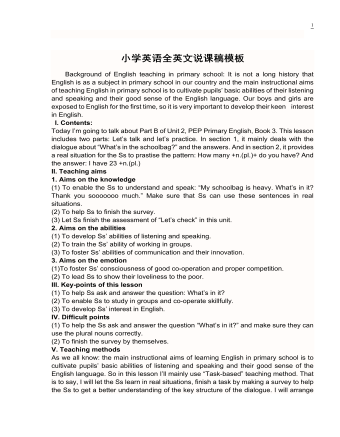
小学英语全英文说课稿模板
1. Aims on the knowledge(1) To enable the Ss tounderstand and speak: “My schoolbag is heavy. What’s in it? Thank you sooooooomuch.” Make sure that Ss can use these sentences in real situations.(2) To help Ss to finish thesurvey.(3) Let Ss finish theassessment of “Let’s check” in this unit.2. Aims on the abilities(1) To develop Ss’ abilitiesof listening and speaking.(2) To train the Ss’ abilityof working in groups.(3) To foster Ss’ abilities ofcommunication and their innovation. 3. Aims on the emotion(1)To foster Ss’ consciousnessof good co-operation and proper competition.(2) To lead Ss to show theirloveliness to the poor.

